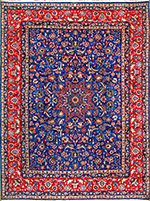Textiles Studies

Textile Research Works
Date of this Version
2002
Document Type
Article
Citation
Bridges: Mathematical Connections in Art, Music, and Science (2002)
Abstract
The Alhambra has often served in the West as the paradigm for understanding geometric pattern in Islamic art. Constructed in Spain in the 13th century as a highly defended palace, it is a relatively late manifestation of an Islamic fascination with geometric pattern. Numerous earlier Islamic buildings, from Spain to India, exhibit extensive geometric patterning, which substantiate a mathematical interest in the spatial dimension and its manifold potential for meaning. This paper examines two monuments on the Iranian plateau, dating from the 11 th century of our era, in which more than one hundred exterior surface areas have received patterns executed in cut brick. Considering context, architectural function, and accompanying inscriptions, it is proposed that the geometric patterns carry specific meanings in their group assemblage and combine to form a programmatic cycle of meanings. Perceived as ornamental by Western standards, geometric patterns in Islamic art are often construed as decorative without underlying meanings. The evidence presented in this paper suggests a literal association of geometric pattern with metaphysical concerns. In particular, the argument rests upon an interpretation of the passages excerpted from the Qur' an that inform the patterns of these two buildings, the visual and verbal expression mutually reinforcing one another. Specifically, the range and mUltiplicity of geometric patterns may be seen to represent the Arabic concept of mithal, usually translated as parable or similitude. The Persian, alam-e mithal, or realm of mithal, assumed increasing importance in the development of Iranian Islamic philosophy and mysticism in the 12th century in the depiction of visionary space. The arguments presented here suggest that the patterns depicted on these two monuments articulate a sacred geometry in early Islamic Iran.
Included in
Art and Materials Conservation Commons, Art Practice Commons, Fiber, Textile, and Weaving Arts Commons, Indigenous Studies Commons, Museum Studies Commons

